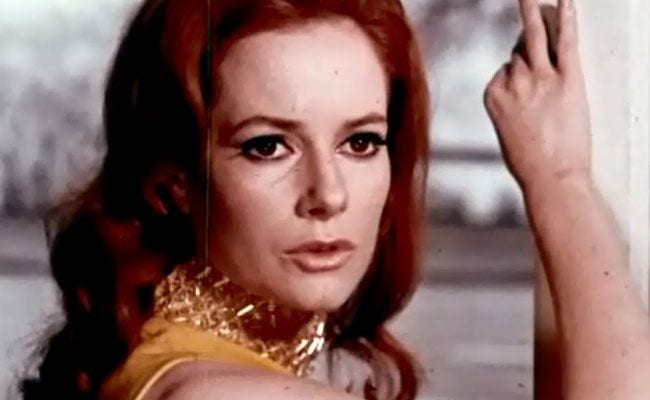
A Failed attempt at film noir, A Black Veil for Lisa (1968) is the story of a young double-crossing socialite who is double-crossed by her older detective husband. Cut from the same cloth as the many giallo films which flooded the market in its day, the film employs the usual template of a giallo with all the absurd twists and turns — minus the blood and thrills.
Suspecting his flighty wife, Lisa (Luciana Paluzzi), of being unfaithful to him, Inspector Franz Bulon (John Mills) begins grilling the red-haired beauty about her whereabouts. Lisa is exasperated with her husband’s insistence that she is straying and continues to dismiss his accusations. As it turns out, Bulon has good reason to suspect that his wife is cheating; it seems she had a brief tryst with a younger man once during the marriage. Bulon wants to believe that he and his wife have moved beyond the rough patches in their relationship, but there’s still that nagging feeling…
Meanwhile, Bulon’s work on the police force has him on the trail of an assassin who is killing off drug dealers. It turns out that the assassin is Max Lindt (Robert Hoffmann), a hitman working for a gang of drug lords who have hired him to pick off their rival dealers. Max is usually careful in his work. But one night during a kill, Max leaves behind incriminating evidence, which Bulon eventually finds. At some point, Bulon catches up with Max.
The inspector also finally learns that his wife is indeed cheating on him, after he spies on her and catches her in the act. Rather than turn Max in, Bulon proposes an offer to the young assassin – one that will finally rid him of his two-timing wife for good.
This is your average paint-by-numbers thriller, where everything you expect to happen does because you’ve seen it too many times before. In a tired romantic angle, Max falls in love with Lisa and this subplot further decelerates an already tedious storyline which struggles to keep a respectable pace.
It doesn’t help that Paluzzi (best known for her role in the Bond film, Thunderball) offers no signs of life in her listless performance. This may have something to do with the poorly dubbed dialogue, but Paluzzi cannot seem to manipulate her facial expressions into anything resembling a sentient creature. There’s no conviction in the language of her movements onscreen and her scenes with the far superior Mills (who would later charm audiences with his Oscar-winning performance in Ryan’s Daughter) painfully reveals her limitations.
For his part, Mills can only work with what he’s given and he turns in a fairly solid depiction of a paranoid curmudgeon. Add to all of this lacklustre direction with an already limp storyline and you’ve got a damp Euro-thriller with noirish pretensions.
The look of the film may certainly appeal to nostalgia-freaks – from the bouffant hairstyles and lilac go-go boots to the tacky wallpapered bedrooms featuring antiquated vanity mirrors. But it smacks of late ‘60s paisley-designed excess; the film is unnervingly frozen in its time period and reveals much of the limitations of its budget (nothing in terms of its art design seems aesthetically arranged for the purposes of cinema; it’s merely props and slap-dashed decor here). This means that in addition to a leaden script, there’s nothing that holds interest visually. It makes the film even more of a chore to get through.
Olive Films’ transfer has cleaned up the film some, but there are still a number of instances where the picture suffers from print damage. Seeing how this was undoubtedly low-budget, the problems may lie in the source print. There are scratches, specks, minor dirt and some flicker throughout. But it isn’t to a highly distracting degree. Colours are fairly muted, though this is most likely because such colours were of popular fashion during the film’s day (muted browns, dull yellows and pea soup greens).
Sound is serviceable and comes through fairly clearly, if a little softly sometimes. Perhaps the only issue with the audio track is that much of the dialogue is dubbed – and not especially well. This wasn’t uncommon of many European films back in the day and A Black Veil for Lisa is no exception. There are no extras on that feature on the disc.
It has to be noted that much of Olive Films’ catalogue consists of obscure and rarely seen films. Which is why it can be argued that releasing a film like A Black Veil for Lisa is warranted, if only for posterity’s sake; the practice of reaching deep into the vaults to retrieve numerous films which were once destined to simply languish is indeed highly commendable. So it’s unfortunate that A Black Veil for Lisa isn’t a winner by any stretch.
If you’re looking for a solid offbeat Euro-thriller, pick up the far superior Olive Films title La Belle Captive, instead.


![Call for Papers: All Things Reconsidered [MUSIC] May-August 2024](https://www.popmatters.com/wp-content/uploads/2024/04/all-things-reconsidered-call-music-may-2024-720x380.jpg)



